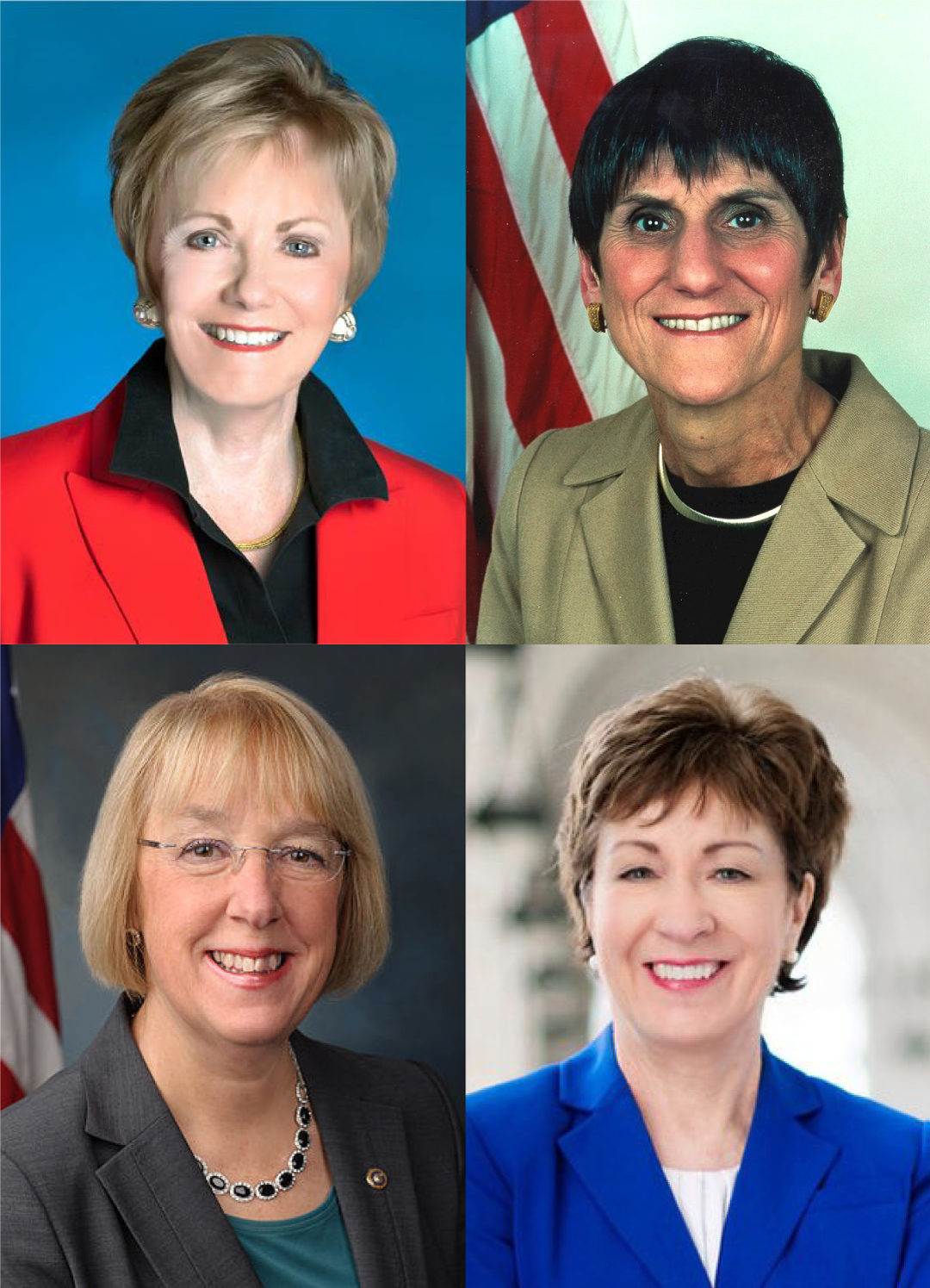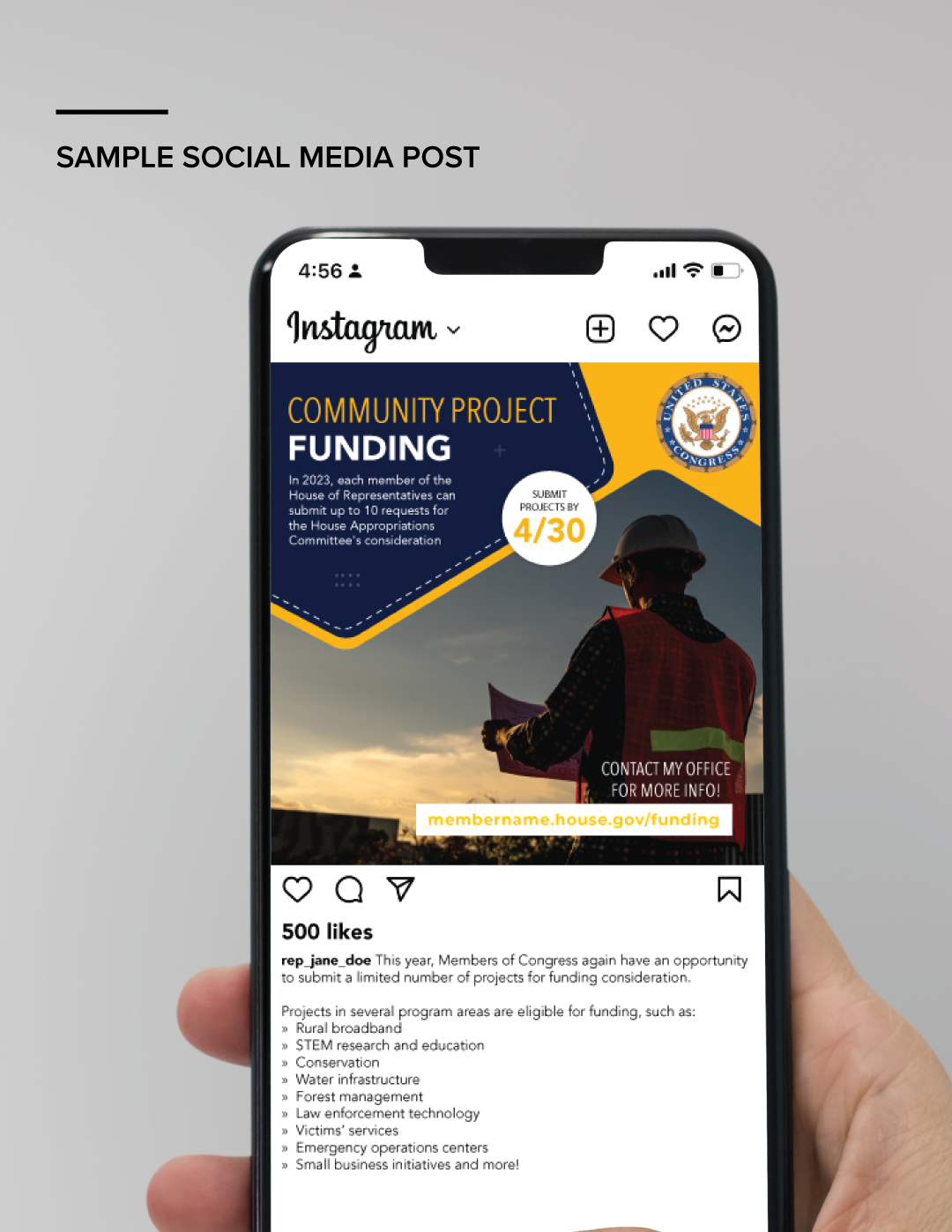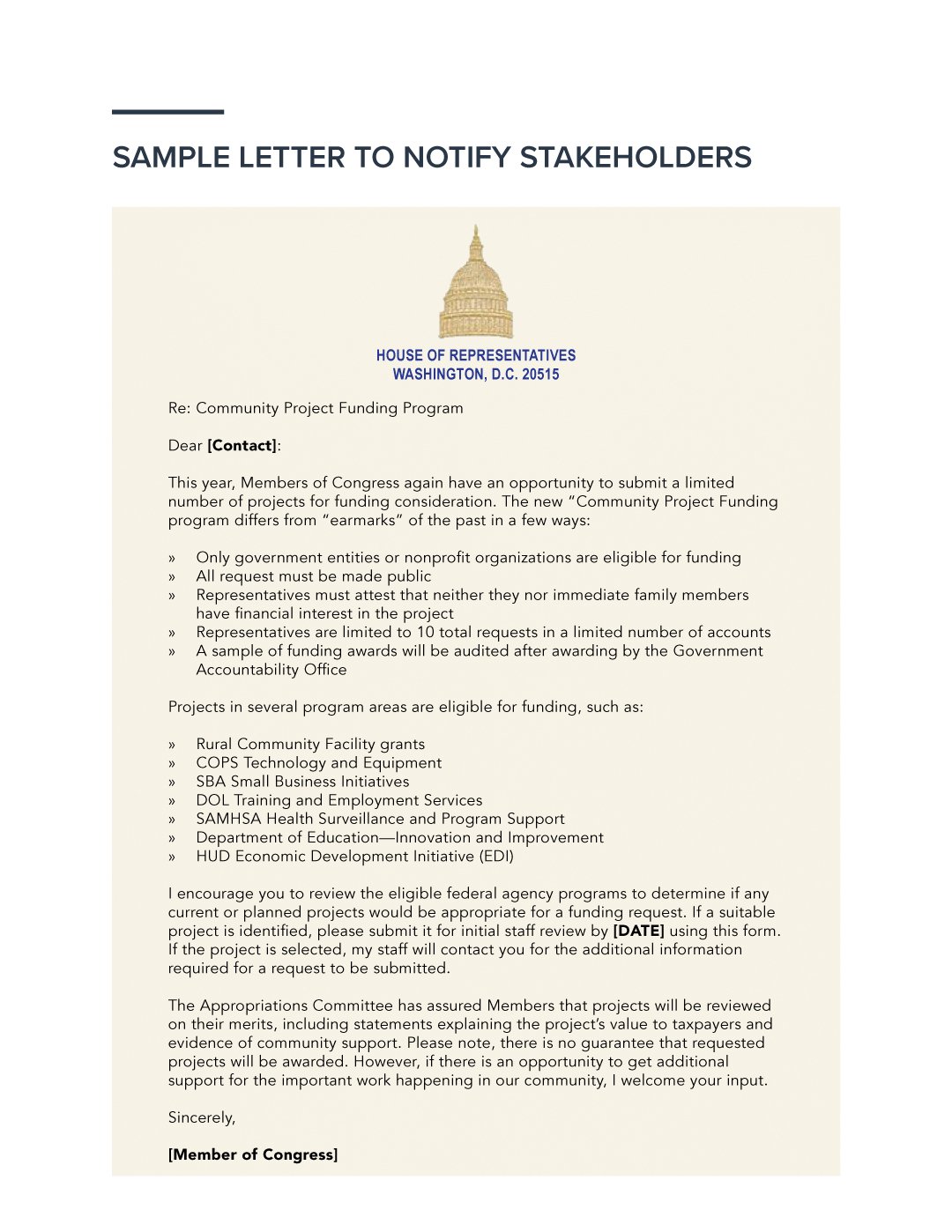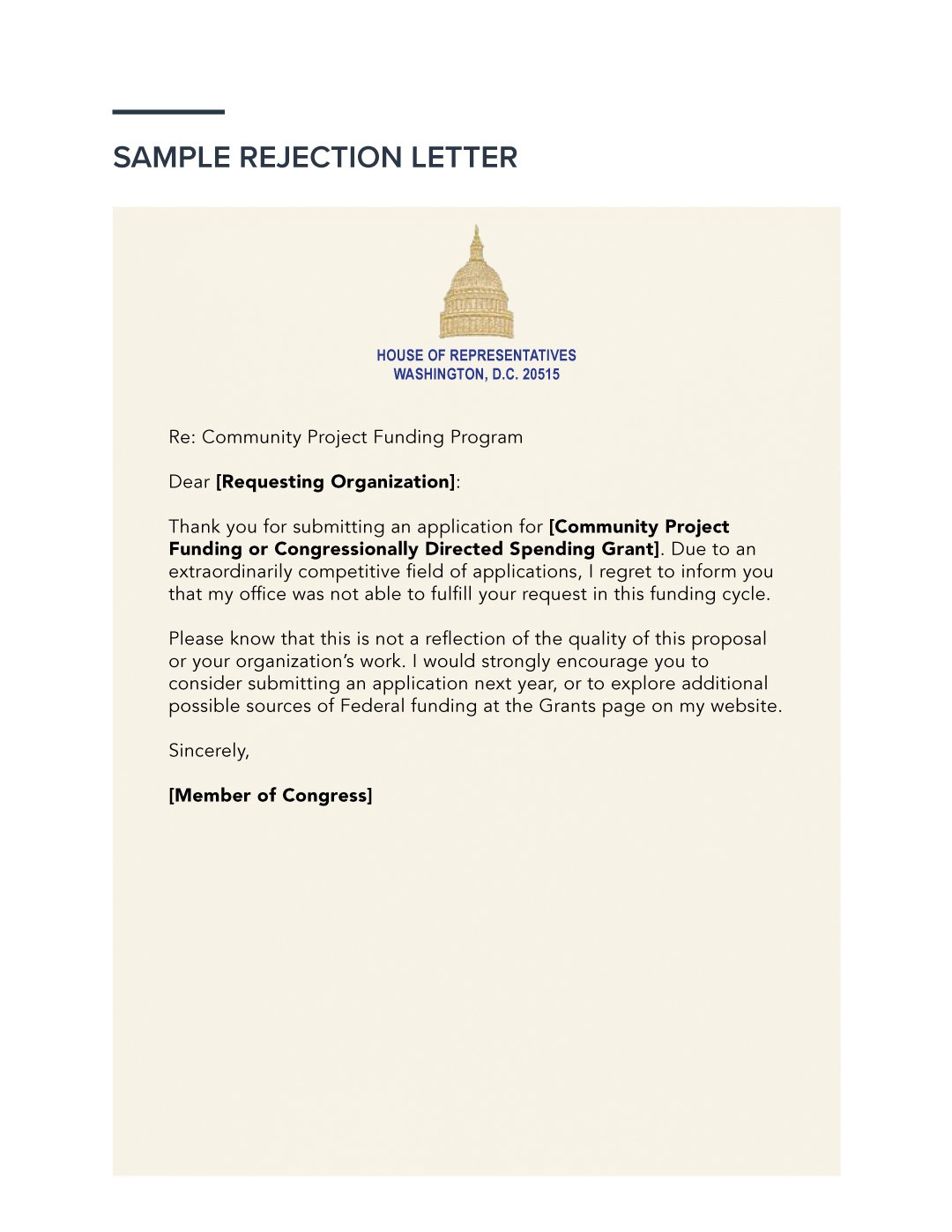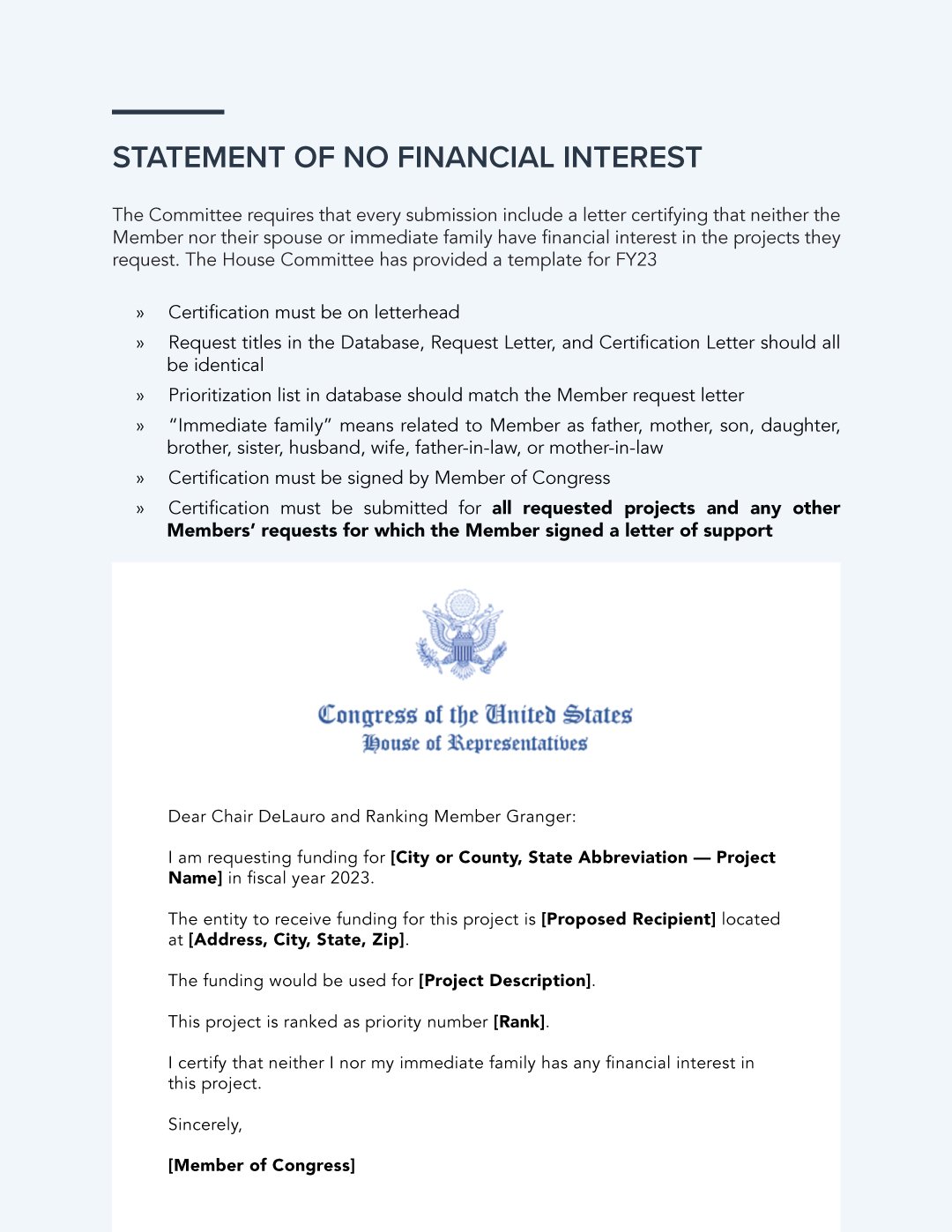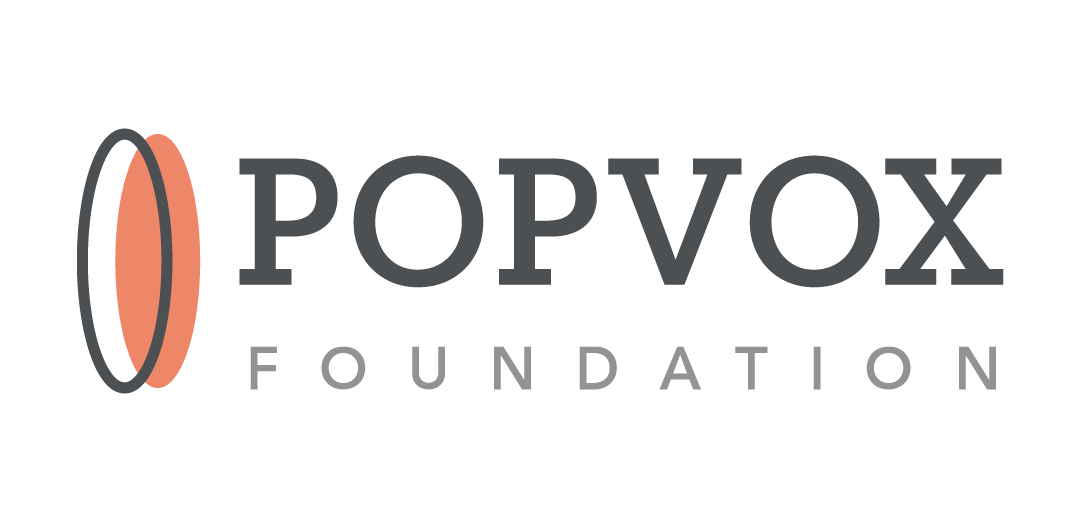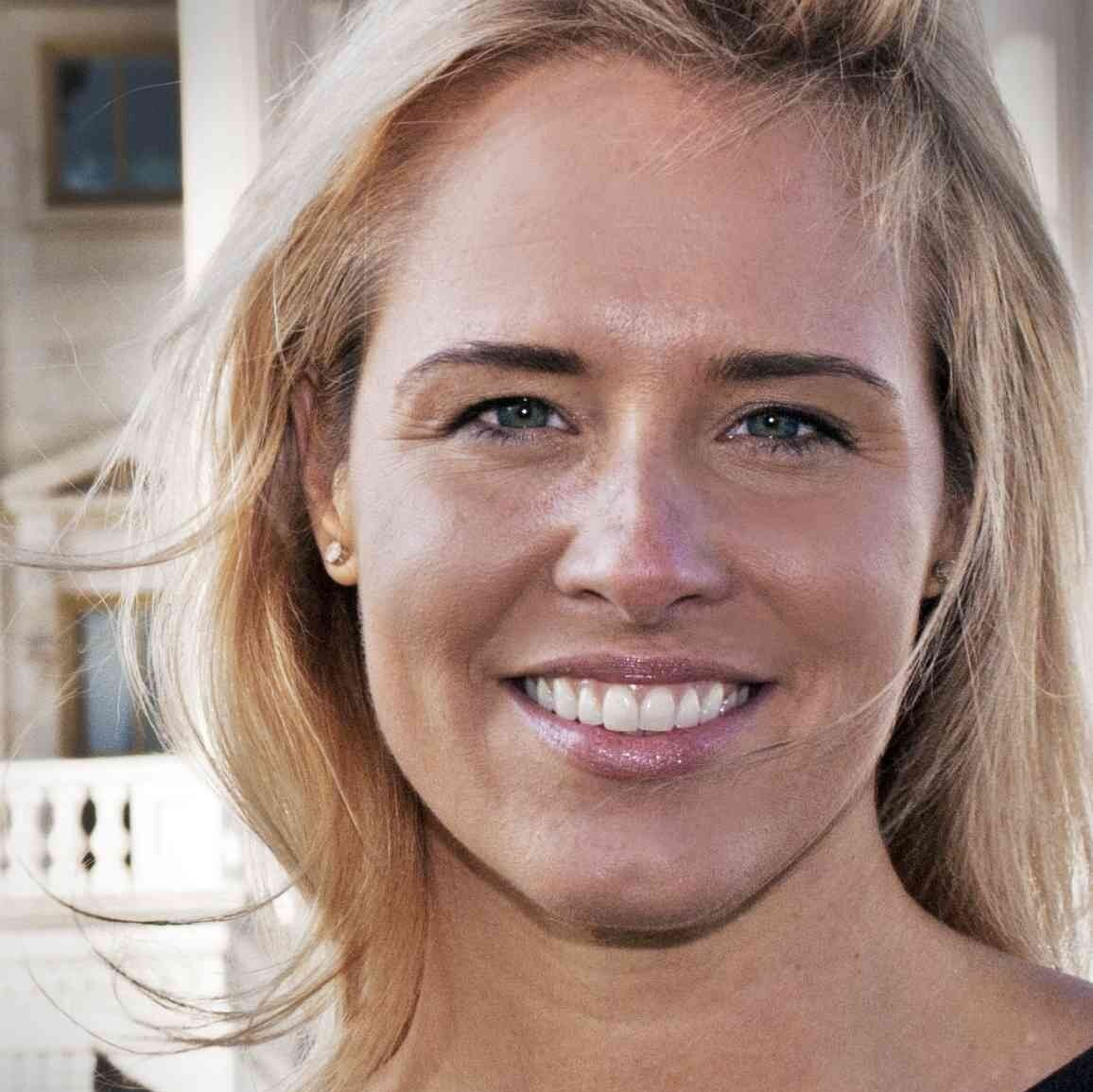A Quick Start Guide to Earmarks for Congressional Offices
Developing an Accountable & Transparent Process
What is Member-Directed Spending?
Eligible Accounts
A Note on Terminology
Setting Up Your Member-Directed Program
Changes for FY24
Checklist for Setup: As Soon As Possible
Sample Timeline
Alerting Constituents to Community Funding Opportunities
Providing Information at Scale
Considerations for Messaging the Program
Evaluating Potential Applicants
Initial Evaluation
Vetting Requests
Present List of Vetted Projects to the Member
Notifying Applicants
Sample Social Media Post
Sample Letter to Notify Stakeholders
Sample Rejection Letter
Statement of No Financial Interest
I. Introduction
Developing an Accountable & Transparent Process
In early Spring 2021, House and Senate Appropriations Chairs announced that both committees would reinstate a modified opportunity for congressionally-directed spending for state and local projects — what was formerly known as “earmarks.”
While the Committees issue overall guidance on these spending programs, the specifics of how to solicit and vet requests for funding from constituents are up to individual Congressional offices. Developing a proactive, transparent process can improve the quality of applications and reduce the amount of time staff spend on processing them.
This guide is intended to serve as an easy reference for Congressional staff to prepare for the 2024 fiscal year (FY24) cycle. We also include best practices and tips for success from the reintroduction of congressionally-directed spending programs over the last two years.
What is Member-Directed Spending?
Member-Directed Spending refers to a subset of federal appropriations that individual Members of Congress can request for projects in their states or districts.
Since the reintroduction of these requests in 2021, Member-Directed Spending requests in both chambers have been subject to certain restrictions.
Narrow Eligibility
Limited to nonprofits and local, state, and tribal government
Specifically Authorized in US Code (House)
For FY24, the House has also required that Members cite the specific legal authorization for projects to ensure projects have a “federal nexus.”
Place-Based
Earmarks are requested for spending in a specific location, rather than for a federal program that may be administered anywhere in the US.
Short-Term
Earmarks are requested in bills that direct federal spending for a specific fiscal year. There is no guarantee of funding in subsequent years.
Subject to Audit
The Government Accountability Office will assess the overall process and review a sample of enacted requests.
Not Guaranteed
The Appropriations Committees of the House and Senate have the ultimate say on which requests make it into initial appropriations bills. Committees also frequently choose to award a smaller amount of funding than requested.
Limited to 1% of Federal Discretionary Spending
This total amount is divided between the two chambers, and proportionally by party.
Not for Museums, Commemorations, or Memorials (House)
Projects named for specific people or entities will not be permitted.
Applicable to a Certain Number of Eligible Accounts
Only certain federal accounts are open for earmark requests, limiting the areas of federal spending that can accept earmarks
Eligible Accounts
For example, areas open in FY24 include:
Education improvement*
Distance learning*
Rural broadband
Agricultural research and management
STEM research and education
Conservation
Conservation education
Water infrastructure and watershed preservation
Forest management
Law enforcement technology
Crime prevention
Criminal justice improvements
Victims’ services
Historical records preservation*
Preservation of historical sites*
Nonprofit security
Emergency operations centers
Pre-disaster mitigation
Employee training and employment services*
Small business initiatives
Entrepreneur training
Health professions education*
Rural health outreach and research*
Telehealth and health IT
Mental health and substance abuse programs
Rural community facilities
Transportation priorities
Economic development
*Only open for requests made through the Senate for FY24.
A Note on Terminology
“Member-Directed Spending” is a catch-all term for these programs in both chambers. However, each chamber has used a different term since the reintroduction of the program in 2021:
Senate: Congressionally-Directed Spending (also known as CDS)
House: Community-Project-Funding (also known as CPF)
Many longtime Congress Members, staff, researchers, the public, and the media also use the term “earmark.” However, both Appropriations Committees discourage the use of this term to clearly separate current Member-Directed Spending programs, with their requirements around additional transparency and accountability measures, from prior programs.
In this guide, we will use Member-Directed Spending as a default, and note differences between the House and Senate programs where relevant.
II. Getting Started
Setting Up Your Member-Directed Program
There are six standard steps for setting up a Member-Directed Spending program in a Congressional office:
Understand the Rules & Set Program Goals
» Internal conversations about prioritizing requests
» Understanding scope and timelinePublic Education & Outreach
» Reach out to local officials & organizations
» Alert the local media
» Host local information sessionsIntake Process to Receive Requests
» Set up an intake form for basic expressions of interest
» Take meetings from potential recipientsRequest Review & Decision
» Vet applicants — both the project and the requesting entity
» HOUSE: Member selects a limited number of projects to request; gathers evidence of community supportSubmission Process for the Relevant Committee
» Notify applicants Member will recommend
» Work on answering all supplemental questions, ensuring matching funding (if required)Communications & Disclosure
» Submit through the Appropriations Committee portal
» Includes statement of no financial interest
» Post on Member’s website
» Communications around successful applicants and funded projects
Changes for FY24
With the change in party control in the House, Hill offices can expect some differences in the program for FY24.
Some program elements are consistent with prior years:
For-profit requestors are still ineligible.
Projects will still be subject to GAO audit.
Members must post requests online; the Committee will also public requests and enacted requests.
House requests require evidence of community support.
House offices may only submit 15 requests.
However, the House has introduced some changes that represent a fairly significant departure from previous years, and from the program as it will be carried out in the Senate:
Total House funding is capped at 0.5% of Federal discretionary spending. The Senate has committed to 1% of discretionary spending; it is not clear how this discrepancy will be resolved in conference negotiations.
Certain categories of spending have been eliminated:
No earmarks for commemorations, memorials, or museums will be accepted.
No earmarks for the Labor-HHS, Financial Services-General Government, or Defense subcommittees will be accepted. This includes accounts covering health care program management, substance abuse management, employment training and support, historical preservation, and more.
Subcommittees are encouraged to provide stricter guidelines for individual accounts. Depending on the subcommittee, this may show up as the chair’s expressed priorities, or additional questions to answer for each request.
Projects have to certify a “federal nexus” for each request, meaning offices have to be able to point to relevant law authorizing projects.
These changes, in addition to the House’s commitment to passing individual appropriations bills under regular order, raise questions about the appropriations process and Congress’s ability to complete it this year. While it would be possible to include Member-Directed Spending requests in a Continuing Resolution (CR), this would be a historic first for Congress.
Rep. Kay Granger [R, TX], Rep. Rosa DeLauro [D, CT], Sen. Susan Collins [R, ME], and Sen. Patty Murray [D, WA] hold the top spots on the House and Senate Appropriations committees, collectively known as the “Four Corners.”
Checklist for Setup: As Soon As Possible
✅ Establish who in your office will be managing the earmarks process
Include roles for earmarks point of contact, outreach and education, communications, process management, review and vetting
✅ Start public education and outreach
Proactively reach out to local entities who may be prime candidates for submissions
» For example, local mayors, fire departments, police departments, superintendents, and well-known nonprofitsPost relevant information on the Member’s website.
» The more you can make publicly available, the less staff time will be required to answer questions and explain the process.Consider scheduling local information sessions to raise awareness of the program
» These may include webinars, town halls, or office hours to answer question from specific requestors
✅ Establish review and vetting process
Consider including criteria your office will use to make decisions in public communications
If your office will be soliciting public feedback or convening an advisory committee on decision-making, invite committee members or decide on mechanism for public comment
Sample Timeline
With deadlines and guidance published in both chambers, it’s time to kick your constituent-facing operation into gear! The following timeline and checklist is a sample to help your team stay organized.
✅ By March 6th
Finalize your intake form
Set your internal deadlines for application
Set up your website with information on your process and your team’s deadlines
Push information about your process out through your networks:
» Newsletter
» Social Media
» Personal emails
✅ Week of March 6th
March 7th: host informal Q&A webinar or drop-in office hours for interested constituents
March 10th: soft deadline for constituents to have submitted at least a partial application
✅ Week of March 13th
Review partially-submitted applications
Perform initial vetting
House: start research for federal nexus
March 14th: final deadline for constituents to submit all required information, including evidence of community support (House)
March 17th: prepare eligible requests for Member review and decision
✅ Week of March 20th
Final vetting and Member decision on requests
Prepare disclosure statements for requests, add signatures
House: finalize research to identify federal nexus for requested projects
March 24th: begin to submit requests to the relevant Committee portals
✅ March 27th: Notify applicants of Member decisions
✅ April 10th–23rd: Post requests to official Member website as downloadable CSV
III. Outreach
Alerting Constituents to Community Funding Opportunities
Congressional offices are already hearing from well-resourced local governments and organizations that have lobbyists, but it should not be necessary to retain a lobbyist to submit a community project for consideration.
One way Member offices can level the playing field is by making clear information available about the new program and reaching out to eligible entities within the district, such as:
Local mayors
County executives
State officials
Law enforcement agencies
Community development entities
Housing authorities
School districts and universities
Local transportation authorities
Agricultural extension stations
Organizations that serve small businesses
Organizations that provide workforce training
Medical and mental health providers
However, it will also be crucial to communicate the uncertainty of the process: while an application for Member-Directed Spending is not as labor-intensive as some other types of federal grant writing, it is nevertheless an investment of time and energy that smaller organizations may not feel is worth the investment for an uncertain payoff.
Keep in mind as you begin outreach that for some requestors, this may be a multi-year process where FY24 is about building awareness for organizations to be ready to submit requests for the first time in FY25.
POPVOX Foundation's DIY Earmarks, a guide to community project funding for local governments and nonprofits, is available at popvox.org/earmarks.
Providing Information at Scale
The short lead-time for submitting requests means that Member offices have to manage their time and resources. One of the easiest ways to make the most of limited staff time is by making information about the program easy to find and easy to understand and holding a webinar (or several) to explain and take questions.
House: Emphasizing the Importance of Community Support
Given the limited funds and need for Members to select specific projects to recommend, some Member offices may prefer to encourage fewer proposals that have broad community support, which is a factor House Appropriators have considered in the past when evaluating requests, such as:
Letters of support from elected community leaders.
Press articles highlighting the need for the requested community project funding.
Support from newspaper editorial boards.
Projects listed in state intended use plans, community development plans, or other publicly available planning documents.
Resolutions passed by city councils or boards, or
Other compelling evidence of community support.
Considerations for Messaging the Program
While every office will have its own way of sharing information about the program, a few key themes will need to be addressed by all, including:
This is not the old “earmark” system.
Significant measures are in place to provide greater transparency and accountability, eliminate self-dealing, and prioritize projects supported by communities.There are no guarantees.
There is no guarantee that ANY requests will be funded, and it is very unlikely that ALL requests will be funded. Given the uncertainty over government funding debates in the 118th Congress, there is also a chance that Congress will not be able to pass new spending bills by the end of the fiscal year, and Member-Directed requests are unlikely to be included in a continuing resolution.Time is short.
The timeline for compiling necessary information and submitting requests is very short. Applicants will need to work closely with staff to get submissions ready in time.Tools for bipartisan wins:
Many requests in the 117th Congress were bipartisan, or supported by Members on both sides of the aisle.
IV. Evaluating Potential Applicants
Initial Evaluation
If the office is considering convening a Community Advisory Board or other public participation mechanism for requests, staff may want to do a preliminary evaluation for inquiries that meet basic eligibility criteria:
Is this request appropriate for a Member-Directed Spending request—i.e. Is the project time-limited and place-based?
Does the requesting entity meet eligibility criteria? (governing entity or nonprofit; not financially connected to the Member or any immediate family of the Member)
Does the project fit into one of the “eligible accounts”?
Vetting Requests
While some requests may be from known entities, some may come in from organizations or entities that are not familiar to the office. Requests that the Member is considering recommending should receive a thorough vetting, including a review of information available through public filings (like 990s for nonprofits), social media, and a search of news articles.
For a more in-depth guide to vetting requests, consult the 8 Steps to Vetting Community Project Funding Requests, summarized here:
Basic Due Diligence
» Check the organization’s 990
» Check for registered foreign agents and major donors
» Check the organization’s public presenceManagement
» Who will oversee the administration and management?
» Have they managed projects of similar scopes and timelines before?Evaluation Plan
» Who will be responsible for evaluation?
» What kind of data will be collected?
» Will it be open to the public?Risk Assessment
» What could happen to throw this project off the rails?
» What would be the impact on your office in the district if the project is unsuccessful?The Funding Weeds
» Start by comparing the amount of funding requested to the organization’s current revenue streams and budgetMission Alignment
» Does this project advance the Member’s priorities?
» what opportunities will the success of this project open up in your community?Community Support
» Consider leveraging existing community relationships to convene a group of stakeholders to act as an advisory panel.The Last Gut Check
» If at any point you feel like an organization is attempting to misrepresent their project, , this is an immediate sign to keep from going any further.
Present List of Vetted Projects to the Member
Once staff have completed the initial review, including any input from an advisory board or public comment, the Member has to decide which projects they want to recommend. Keep in mind that not all requests will be funded, or funded at requested level.
In previous cycles, the House also has additional rules for Members to consider in prioritizing projects:
In FY24, the Member may recommend up to FIFTEEN projects (sign-on letters of support for other Members’ requests did not count against the 10 projects, but Members were strongly encouraged to submit financial certifications for projects for which they submit letters of support).
The Member was required to rank recommended projects in order from 1–15.
Notifying Applicants
Once the Member has selected the projects they would like to recommend, it is important both to let those projects that didn’t advance know that no further action is needed and to work with recommended projects to refine their proposals and ensure they have submitted all necessary information.
In FY22 and FY23 processes, some otherwise successful applicants have experienced delays in receiving funding because they did not meet agency requirements—for example, nonprofits that had not finalized their 501c3 status with the IRS, or had not set up their account with the Federal System for Award Management (SAM). Encourage your successful applicants to check in with the agencies they will be working with to receive funding to make sure they are ready to proceed if their requests are included in the final bill.
V. Resources
Developed By
Bipartisan Policy Center
The Bipartisan Policy Center is a Washington, DC-based think tank that actively fosters bipartisanship by combining the best ideas from both parties to promote health, security, and opportunity for all Americans. Our policy solutions are the product of informed deliberations by former elected and appointed officials, business and labor leaders, and academics and advocates who represent both sides of the political spectrum.
POPVOX Foundation
POPVOX Foundation works “to inform and empower people and make government work better for everyone.” This includes reimagining the concept of “civic infrastructure,” and providing new ways for government to share information and engage the public, with an emphasis on diverse participation and rebuilding public trust.
Franz Wuerfmannsdobler
Franz Wuerfmannsdobler is a Senior Advisor with the Bipartisan Policy Center. He has more than two decades of congressional experience. During his tenure on Capitol Hill, he worked in the offices of U.S. Senators Robert Byrd, Byron Dorgan, and Chris Coons, the last of which he served as the Deputy Chief of Staff and Senior Policy Advisor. He also served on the Senate Appropriations Committee. His policy portfolio has included energy, environment, science and technology, appropriations, and budget issues. Building on these experiences, he is dedicated to improving public discourse and restoring civic trust.
Marci Harris
Marci is CEO and cofounder of POPVOX, Inc., a nonpartisan platform for civic engagement and Executive Director and Co-Founder of the POPVOX Foundation. She later served as counsel to the chairman of the Ways and Means Health Subcommittee in the U.S. House of Representatives, working on the team that drafted the Affordable Care Act. Marci left Capitol Hill in 2010 to create POPVOX.com and has continued to work at the intersection of technology and policy. Marci is a lecturer at San Jose State University and the University of California Berkeley Haas School of Business and an adjunct professor at the University of San Francisco School of Management.
Anne Meeker
Anne is a civic process and democratic engagement nerd, and a former House district staffer. She was a founding member of the POPVOX Foundation team as Director of Special Initiatives. She previously served as Director of Constituent Services for Congressman Seth Moulton, where she worked to use data and technology to deliver smarter casework services to residents of the MA06. Anne holds a bachelor's degree in Anthropology from the University of Oxford (St. Hugh's College), and an MSc in History from the London School of Economics, where she wrote her thesis on presidential memoir.




